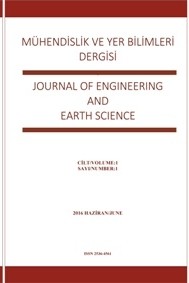Katyonlar Varlığında Karışık Mineralli Kilin Zeta Potansiyeli
Bu çalışmada, karışık mineralli kil (KMK) örneğinin Na+, Li+, Ca2+ tuz katyonları ve Zn2+, Cu2+, Al3+ metal katyonları varlığında zeta potansiyeli değerleri ölçülmüştür. Genel sonuçlar incelendiğinde, zeta potansiyeli değerlerinin iki değerlikli ve üç değerlikli katyonların varlığında daha pozitif olduğu görülmektedir. Metal iyonların varlığında KKM’nin zeta potansiyeli davranışının benzer olduğu görülmektedir. Metal iyonların konsantrasyonundaki artış, pH 7 civarına kadar zeta potansiyelini pozitif değerlere doğru olarak arttırmakta, ve pH 7 civarında zeta potansiyeli pozitif değerler almaktadır. Metal iyonları genellikle iki adet sıfır yüklü nokta (syn) meydana getirmiştir. KKM’nin zeta potansiyel değerleri saf montmorillonit ve saf kaolin ile karşılaştırılmıştır.
Anahtar Kelimeler:
Elektrokinetik dekontaminasyon, karışık mineralli kil, sıfır yük noktası, zeta potansiyeli
The Zeta Potential of a Mixed Mineral Clay in the Presence of Cations
In the present study, zeta potential of a mixed mineral clay (MMC) was measured in the presence of salt cations; Na+, Li+ and Ca2+ and metal cations; Zn2+, Cu2+, and Al3+. Results reveal that the zeta potential of the MMC, in general, becomes more positive in the presence of divalent and trivalent cations. In presence of metal ions the zeta potential of the MMC has similar trends, i.e., increase in the concentration of these ions causes an increase in the zeta potential to the positive values up to around pH 7, and then it becomes positive; and produces generally two apparent pzcs (point of zero charges). The zeta potential values of the MMC were compared with those of pure montmorillonite and pure kaolinite.
Keywords:
Electrokinetic decontamination, mixed mineral clay, zero point of charge potential, zeta potential,
___
- Acar Y.B. & Alshawabkeh, A. N. (1993). Principles of electro-kinetic remediation. Environmental Science and Technology, 27, 2638-2647.
- Chapman, H. D. (1965). Cation exchange capacity. in: Met-hods of Soil Analysis (Edited by J.A. Black), Agronomy; Ame-rican Institution of Agronomy, Madison, Wisconsin, 9, 891-901.
- Çelik, M. S., Akin, Y., & Hancer, M. (1996). Decompression of electrical double layer with monovalent cations. Society for Mining, Metallurgy, and Exploration, Inc., 1-5, USA.
- Dillard, J. G. & Koppelman, M. H. (1982). X-ray photoelect-ron spectroscopic (XPS) surface characterization of cobalt on the surface of kaolinite. Journal of Colloid and Interface Science, 87, 47-55.
- Dzenitis, J. M. (1997). Soil chemistry effects and flow predic-tion in electrokinetic of soil. Environmental Science and Tech-nology, 31 (4), 1191-1197.
- Eykholt, G. R. & Daniel, D. E. (1994). Impact of system che-mistry on electroosmosis in contaminated soil. Journal of Geotechnical Engineering, ASCE, 120 (5), 797-815.
- Hunter, R. J. & James, M. (1992). Charge reversal of kaolinite by hydrolyzable metal ions: an electroacoustic study. Clays and Clay Minerals, 40, 644-649.
- Kaya, A. & Yukselen, Y. (2005). Zeta potential of soils with surfactants and its relevance to electrokinetic remediation. Journal of Hazardous Materials, B120, 119-126.
- Kim, S. O. Moon, S. H., & Kim, K. W. (2001). Removal of heavy metals from soils using enhanced electrokinetic soil processing. Water, Air and Soil Pollution, 125, 259-272.
- Mitchell, J. K. (1993). Fundamentals of soil behavior, 2nd edition, America: John Wiley & Sons, USA.
- Page, M.M. & Page, C.L. (2002). Electroremediation of Con-taminated Soils. Journal of Environmental Engineering, 128, 208-219.
- Schroth, B. K. & Sposito, G. (1997). Surface charge properties of kaolinite. Clays and Clay Minerals, 45, 85-91.
- Shapiro, A.P. & Probstein, R.F. (1993). Removal of contami-nants from saturated clay by electroosmosis. Environmental Science and Technology, 27(2), 283-291.
- Vane, L.M. & Zang, G.M. (1997). Effect of aqueous phase properties on clay particle zeta potential and electro-osmotic permeability: implications for electro-kinetic soil remediation processes. Journal of Hazardous Materials, 55, 1-22.
- West, L. J. & Stewart, D. L. (1995). Effect of zeta potential on soil electrokinesis, ASCE, Geotechnical Special Publication, 1535-1549.
- Yong, R. N. & Warkentin, B. P. (1966). Introduction to soil behavior. Newyork: The Macmillan Company, USA.
- Yukselen, Y. (2001). A study on the zeta potential of clay minerals in the presence of various chemical conditions. M.Sc. Thesis, Summited to Dokuz Eylul University Graduate School, Turkey, 136p.
- Yukselen, Y. & Kaya, A. (2003). Zeta potential of kaolinite in the presence of alkali, alkaline earth and hydrolysable metal ions. Water, Air, and Soil Pollution, 145 (1), 155-168.
- ISSN: 2536-4561
- Başlangıç: 2016
- Yayıncı: Remzi BAŞARI
